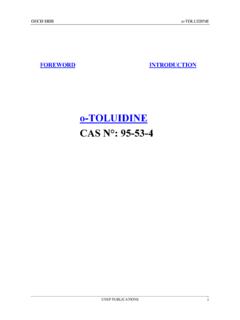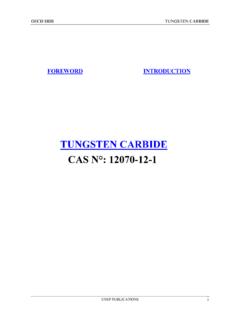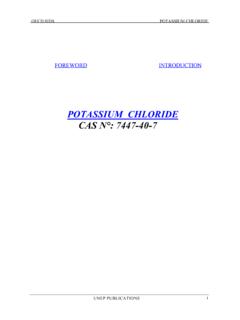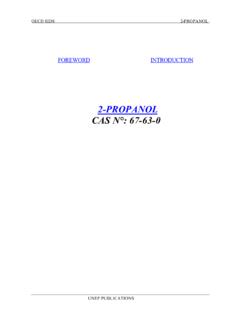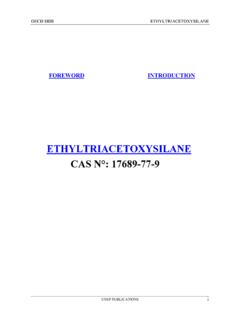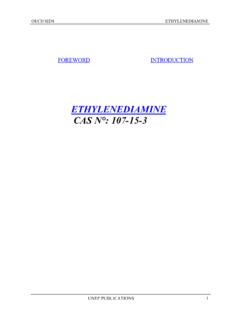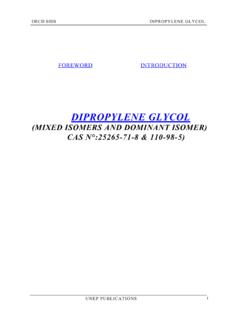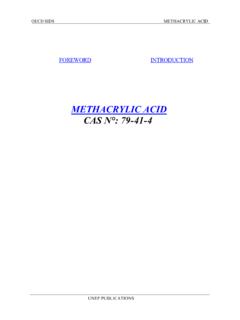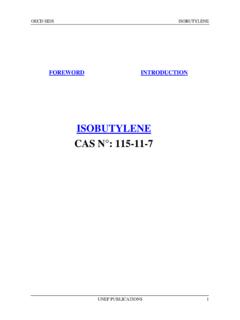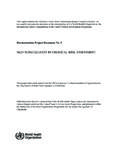Transcription of OECD SIDS BENZALDEHYDE - inchem.org
1 OECD SIDSBENZALDEHYDEUNEP PUBLICATIONSFOREWORDINTRODUCTIONBENZALDE HYDECAS N : 100-52-7 Identifiers, Physical and Chemical properties123 CAS Number : 100-52-7 End Point : IDENTIFIERS, PHYSICAL AND CHEMICAL PROPERTIESS ubstanceChemical Name : BenzaldehydeCommon Name : BenzaldehydeRTECS Number : CU4375000 Properties & DefinitionsMolecular Formula : C7H6 OMolecular Weight : Point : -26 CBoiling Point : : LiquidFlash Point : 64C (c-cup)Density : g/cm3 at 20 CVapour Pressure : kPa ( mmHg) at 20 COctanol/Water Partition : experimentalWater Solubility : g/L at 25 CSolubility in other : SolventsMiscible with alcohol, ether, : Burning aromaticImpurities : Toluene, benzoic acidGeneral Comments :Freezing point = -56C.
2 For water solubility the value g/L at 25C is also given. FP (o-cup) = 74C. Auto-flammability = 190C. Strongly reactive. Becoming yellowish on keeping. Volatile with steam. Keep tightly closed andprotected from almond oilBenzaldehyde FFCB enzenecarbonalBenzenecarboxaldehydeBenzo ic aldehydePhenylformaldehydePhenylmethanal Synonymslog Pow = ENVIRONMENTAL EXPOSUREB iodegradability: "readily biodegradable"RELEASE AND SOURCESP roduction of BENZALDEHYDE (Botlek):Emission to air calculated for 8300 production hours/year at the Botlek facility is for 6 pumps in total 275 kg/year and for 83 valves in total 1382 kg/year. This leads to continuous release to air of 5 kg/day.
3 The storage tank is provided with a carbonfilter, so it can be assumed that emissions are very small. There is almost norelease to water as process water is incinerated as chemical waste or of BENZALDEHYDE (SP-South Geleen):Process water is incinerated or recycled, no discharges occurs into the of BENZALDEHYDE (SP-South Geleen):After processing the waste water is incidentally discharged to the process sewer and then via several canals to the IAZI (Integral Waste Water Purification Installation). The IAZI at the DSM site Geleen has a capacity of 1 million inhabitants equivalents and a 4500 m3/hour influent. It is assumed that 300 kg BENZALDEHYDE /day is released into the influent of the IAZI.
4 The emission levels to air of the purification installation in Geleen are low: toluene: = kg/day, BENZALDEHYDE : = kg/day and benzylformiate : = EvaluationIRPTC Data Profile Identifiers, Physical and Chemical properties124At the Botlek site yearly "personal monitoring" has only been carried out for aromatic hydrocarbons and not for BENZALDEHYDE . In Geleen no personal sampling measurements have been carried out the German production and processing site, the emissions into waste water during processing is < 1 t/y. The release during production is not AND FATEB enzaldehyde is a highly soluble and readily biodegradable chemical with a log Kow of A DT50 for photodegradation of hours was calculated for the reaction with OH-radicals.
5 Results from Mackay level 1 calculation indicate that 29%, 68,8%, and 4% will partition into air, water, soil and sediment, EXPOSURES ince BENZALDEHYDE is approved as a direct and indirect food additive consumers can be exposed by the oral route. BENZALDEHYDE is also approved as a fragrance additive and is reported to occur in several essential oils, notably hyacinth, citronella and cinnamon. It is also used as a solvent for resins. Therefore consumers can also be exposed dermally and after EXPOSUREIn the Netherlands occupational exposure can occur during production, transportation and purification. No data on workplace monitoring have been reported.
6 Occupational exposure is probably low since no complaints concerning smell and irritation were expressed by workers. Both thresholds are very low (odour threshold: ppm; irritation occurs at 4 ppm).Workplace exposure measurements of BENZALDEHYDE have been carried out in Finland in some , as one of the numerous aldehydes emitted when cutting the painted metal components with propan-gaz welding flame, was measured at a concentration of BENZALDEHYDE concentration inside a small hut made of artificial element materials was mg/m3 (Malm, 1994). sids INITIAL ASSESSMENTThe human and environmental profiles presented in this assessment describe the risk from the plant in the Netherlands (production at the Rotterdam Botlek site).
7 The risk assessment is carried out using the Uniform System for the Evaluation of Substances (USES) (RIVM,VROM & WVC, 1994).Assumptions made are: produccion: 25000 tonnes/year of which 500 tonnes/year is used as a food and fragrance additive. processing: Use as on-site intermediate at Gleen 60% of 25000 tonnes/year. HUMANI ndirect:The human effects alone indicate a low degree of toxicity. From the USES model, based on production figures it is calculated that the margin of safety (MOS) between the NOAEL and the data for indirect exposure is 35000.
8 Based on the ADI the MOS is processing figures the margin of safety for indirect exposure is +7 Based on the ADI the MOS is +7 Consumers:Oral exposure to BENZALDEHYDE from its use as a food additive can occur and is regulated based on the established ADI of 5 mg/kg body weight as benzoic acid :No monitoring data are available. Exposure will probably be very low since no complaints concerning smell and irritation were expressed by workers (odour threshold: ppm).ENVIRONMENTALE cotoxicological data indicate that BENZALDEHYDE is acutely toxic to fish, harmful to daphnia and very slightly toxic to algae. Using an uncertainty factor of 100 on the lowest LC50 to fish a PNEC (Predicted No Effect IRPTC Data Profile Identifiers, Physical and Chemical properties125 Concentration) of ug/L is calculated, for aquatic production discharges to water are negligible as all waste is recycled or incinerated.
9 There are no indication for a risk to the releases to water during processing is estimated that the BENZALDEHYDE concentration in the influent is 300 kg/ (400 x 24 m3) = mg/L. Applying the model USES an effluent concentration of 94 ug/L is using a dilution factor of 32 the concentration in surface water 1000 m from the discharge point is PEC/PNEC ratio according to the USES data is = a NOEC of 132 mg/L a PEC/PNEC ratio of < for microorganisms in the IAZI is calculated. However, if the lowest EC50 of mg/L is used there is still no risk for microorganisms in a waste water treatment on an EC50 of 624 mg/kg for lettuce a PNEC of mg/kg is calculated for soil organisms.
10 Applying a scenario of USES in which sewage sludge is applied on agricultural land a PEC/PNEC ratio of < is upon the available information, the initial assessment gave no indications for concern for humans for indirect exposure and no indications for concern for the aquatic environment. The assessment is considered to be limited by:- the lack of exposure data: workers and aquatic on human as well as environmental exposure is needed in particular with respect to other producers and processing Data Profile Production-Trade126 CAS Number : 100-52-7 Production-TradeGeographic Area : NLDC hemical Name : Benzaldehyde1987-1993 Production15000-25000 t/y - PQuantityYearGeneral Comments : About 15000 tonnes per year is produced in the USA, Japan, Germany and another EU !
